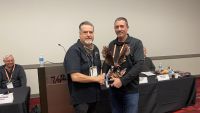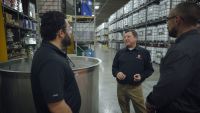Contractor to Contractor: Anastasi Masonry Corp.
By Masonry
Masonry: What do you feel is the biggest misconception about the masonry industry?
Anastasi: The biggest misconception is that there's a lack of qualified masons to do the work. That's the perception a lot of general contractors and architects have, that there are few qualified masons and mason contractors that can do the work. That's hogwash.
I'm the president of the Masonry Association of Florida. Apprenticeship is our number one priority. Florida is a right-to-work state and we have a problem in that there is no one training outside the union and this is not a union market. The contractors got pro-active and were doing something about it.
We established the Masonry Association of Florida to train apprentices and promote masonry. We are accomplishing this through state and local agencies and currently have more than 450 students in masonry apprenticeship programs. For example, in our county there's enough funding for a masonry lab, an instructor, and a coordinator to go out and visit the job sites to recruit new apprentices.
Masonry: What would you do besides the apprenticeship program to change that misconception?
Anastasi: Marketing is very important. One thing we do in the Masonry Association of Florida, following the MCAA model, is that we give Excellence in Masonry Awards in 10 categories. Each chapter has a competition; the winner in each category is submitted to the statewide competition.
At the MAF state convention, we recognize the top three projects in each category. We give plaques to the general contractors and architects, as well as certificates to all the vendors. The mason contractor walks away with a beautiful trophy. We do this at a gala dinner, using a PowerPoint presentation, for approx 100 to 200 people. That's the marketing end.
Masonry: What are your three biggest concerns in keeping your company successful?
Anastasi: Improve our marketing; that would be number one. Second, redefine and reassess our target market. I believe we should get into alternative masonry systems, such as segmented retaining walls. Third, assess and do value engineering against competitive wall systems. That ties back to marketing. A split face or brick veneer masonry job in the long run is cheaper and more economical when you start factoring in maintenance and things of that nature.
Masonry: What do you feel are the industry's biggest challenges in the near future?
Anastasi: First, to continue the focus on training a viable work force along with refocusing on marketing to solidify our marketplace. Second, dealing with legislative issues that will impact our marketplace. Third, combating a real lack of willingness on the part of too many mason contractors to getting involved.
There are many mason contractors who are not members of local masonry associations, or MCAA, or who fail to join related organizations such as ACI (Association of Construction Inspectors), or ASTM (American Society for Testing and Materials). After all, those two organizations directly affect our industry every day.
If they would join the ASTM, and become members of a technical committee, they would have an opportunity to review and vote on proposed changes to ASTM Standards.
Fortunately, there are some very proactive individuals doing that right now. I was very pleased with the election of William McConnell as the president of the MCAA; he has been very active on legislative issues, including OSHA. He truly understands the impact of legislative issues — after all, he is one of us.
The other person who comes to mind is Jerry Painter of Painter Masonry, Gainesville, Fla. Jerry is constantly working on issues that affect the masonry marketplace — he is an active member of both ASTM and ACI.
Masonry: Where do you think the masonry industry is going to be 10 years from now?
Anastasi: Ten years ago, no one knew what a segmented retaining wall was; now you see them everywhere. I think they opened up a new marketplace.
I think over the next 10 years, we'll continue to lose market share in the construction of industrial, warehouse and retail centers to alternative wall systems such as tilt-ups. We have a problem right now; not only is tilt-up used in the commercial, retail and warehouse marketplace, but some school boards are allowing general contractors to design/build with tilt-up. So it's definitely cutting into our marketplace.
Where do I see it going? Hopefully we will be able to maintain market share and make growth in new markets. However, I do feel there's a major competition and threat from competitive wall systems. We have to be careful and do a better job marketing masonry.
Masonry: What do you feel are the most critical issues you'll face with future government regulations?
Anastasi: First is the ergonomics issue. I believe that will have a tremendously negative impact on our industry. When we were at our last state convention, there were quite a few comments made about having to give bricklayers a 15-minute break every two hours. Quite frankly, if that happens we're opening a door to competitive wall systems because masonry will be too cost prohibitive. I think government needs to take a laissez-faire attitude toward the masonry industry.
We are a proactive, safety-oriented firm, continually looking to improve our safety program, on a daily basis. There's always something new to learn. The current laws are very good but I do believe they need to be reassessed. You can provide all the training in the world, and it only takes one individual acting foolish in front of an OSHA inspector and you're faced with a tremendous fine. I don't think it's entirely fair to hold the employer solely responsible.
Masonry: Which group do you feel has the bigger impact on masonry's future, architects, engineers, or general contractors?
Anastasi: I think it's a combination of all three, but the design professional has the greatest influence. I rank the architects and engineers equally beneficial or detrimental. We had a major hurricane here, Hurricane Andrew. Because of that catastrophic incident, masonry was thrust to the forefront as the viable building product. In that sense, the engineers were the ones who designed the wall systems utilizing masonry to meet the current wind load requirements.
Masonry: What about the owner?
Anastasi: If the owner has, let's say, gray hairs, and has gained wisdom through experience, I think he will utilize masonry over any other building system every time. Masonry is a viable system, an economic system and, in the long run, I don't think there is a more competitive wall system out there.
Masonry: What do you like most about being a member of MCAA?
Anastasi: Networking. The channel MCAA provides its members to legislative issues. Continuing education.
One of the things we utilize MCAA for quite a bit is the training manuals, both for apprenticeship and certification for competent people such as forklift drivers. We have purchased these programs in the past and have found them to be very good.
About the Author
Masonry, the official publication of the Mason Contractors Association of America, covers every aspect of the mason contractor profession - equipment and techniques, building codes and standards, business planning, promoting your business, legal issues and more. Read or subscribe to Masonry magazine at www.masonrymagazine.com.


















